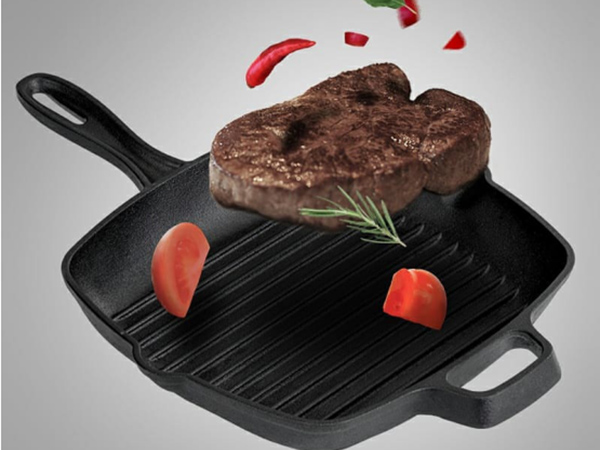How to Choose a Grill Pan and Grilling the Food
Grill pans provide a great way to mimic the experience of outdoor grilling. They’re especially useful for people who live in apartments. However, using a grill pan is different than cooking with regular stovetop pans. There are several things you need to do so your food cooks properly and has char marks and a grilled taste. Ultimately, by preparing your pan and food, taking steps to properly gill your food, and seasoning and storing your pan, you’ll be able to use your grill pan to its full potential.

Choosing a Grill Pan
1
Pick a pan with raised ridges. Generally, cast iron grill pans with dramatically raised ridges are better than those with gentle or shallow ridges. Ultimately, the deeper the ridges, the more dramatic your sear mark. In addition, the larger the ridges, the more grill-like your final product will appear. Look for a grill pan with ridges that are taller than 1⁄2 centimetre (0.20 in).

2
Choose a cast iron pan. Cast iron pans tend to retain more heat than pans with a nonstick surface. In addition, cast iron pans tend to mimic the grill better than nonstick surfaces. Finally, cast iron pans will sear your food better than nonstick pans.
3
Go with a square-shaped grill pan. Round grill pans work fine, but they offer less surface area than square grill pans. With a square grill pan, you'll have more room to cook your favorite meats and vegetables.

4
Look for a grill pan with a matching press if you want defined grill marks. Some grill pans come with matching presses you can use to press the down the food as it cooks to enhance the grill marks. You can still get grill marks without a press, but they may not be as defined or even.
Please check below our grill pan with a matching press sets, we, Shijizhuang Zhengzheng Technology Co., Ltd is a leading Enameled Cast Iron Cookware Manufacturer located in Shijiazhuang City, for more models of cast iron cookware


Grilling Your Food

1
Preheat the pan on medium high. Allow the cast iron grill pan to heat for at least five minutes. By doing this, you’ll make sure the entire surface of the pan is equally hot. This will ensure your food cooks evenly. In addition, it’ll help you get good char/grill marks.
2
Place your food on the pan. When the cast iron pan has had sufficient time to heat up, you’ll need to gently place your food in it. Do so with tongs or other grill equipment. Allow half an inch (1.25 cm) between large items (like pieces of chicken or steak). Lay the food perpendicular to the grill ridges so you get grill marks.
3
Avoid moving food for about one minute. Once you place the food onto your grill pan, you shouldn’t flip it or move it for about a minute. By leaving it in place, you’ll help create those sear/grill marks that add so much character to your food.
4
Rotate or move your food after a minute or two if needed. If you think your food is burning or cooking unevenly, use tongs to rotate the food slightly. Depending on the food, your pan, and your stove, you may need to experiment to determine how often you need to rotate your food.
Keep in mind that rotating the food will cause the grill marks to be diamond-shaped instead of straight lines.
5
Flip your food. Once you’ve rotated your food and allowed it to sit for several minutes, you’ll need to flip it. Flipping it is important so that you cook the food evenly. In addition, flipping your food will help prevent burning.
If you’re cooking steak that is about 1 inch (2.5 cm) thick, allow it to sit for 3-5 minutes on one side before moving or flipping it.
If you’re cooking chicken that is about 1 inch (2.5 cm) thick, allow it to cook for 5-10 minutes on each side.
Let pork cook for 6-7 minutes on one side before flipping it.
Flip burgers after 3 minutes.
Cook bratwurst for 5 minutes before flipping.
Allow shrimp to cook for 2-3 minutes before flipping.
Let vegetables cook for 3-4 minutes on one side before flipping them over.
If you notice your food charring or burning too much, flip it more. If it continues to burn, turn your heat down.
6
Take the temperature of your food. If you’re cooking meat, you should take its temperature before you remove it from the cast iron grill pan. This way, you’ll make sure the inside of the meat has risen to minimum temperatures that will guarantee it is safe to eat. Without taking the temperature, you’ll simply be guessing about whether the food is done and safe.
Shellfish should be cooked to 145 degrees Fahrenheit (63 degrees Celsius).
Poultry should be cooked to 165 degrees Fahrenheit (74 degrees Celsius).
Beef, pork, veal, and lamb should be cooked to 145 degrees Fahrenheit (63 degrees Celsius).
Ground meat should be cooked to 160 degrees Fahrenheit (71 degrees Celsius).
For the second part, grilling the food, we sincerely hope that it will help your customers when using the cast iron grill pan, for the enamel cast iron grill pan and cookware

